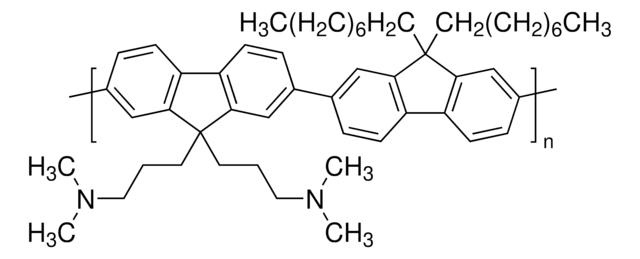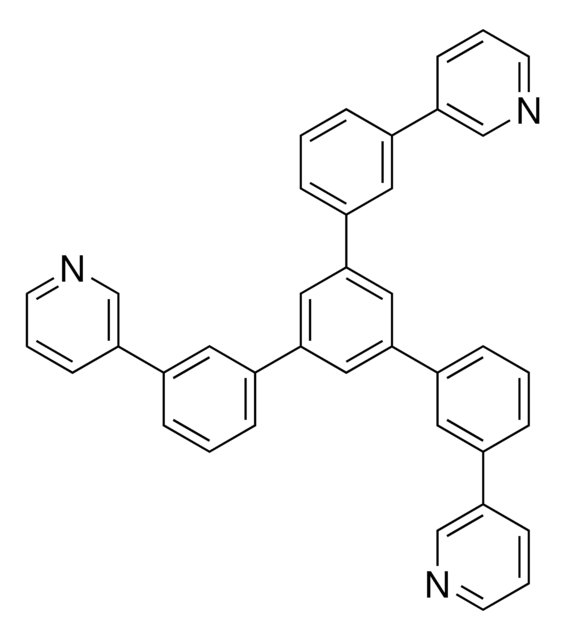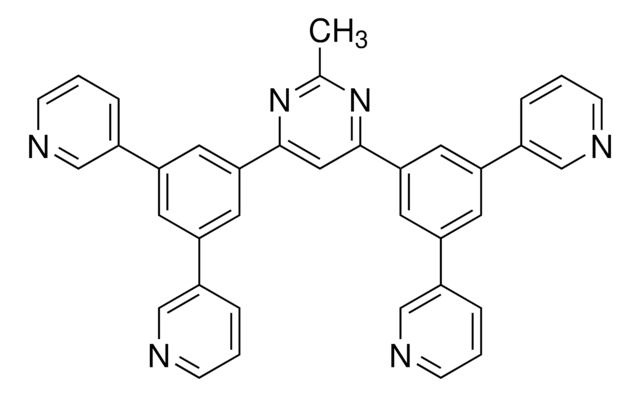907065
Poly-TPD
Mw ≥20,000 g/mol
Synonym(s):
4-Butyl-N,N-diphenylaniline homopolymer, Poly(4-butyl-N,N-diphenylaniline), Poly(4-butyltriphenylamine), Poly[N,N′-bis(4-butylphenyl) -N,N′-bis(phenyl)-benzidine]
Sign Into View Organizational & Contract Pricing
All Photos(1)
About This Item
Linear Formula:
(C22H21N)n
CAS Number:
MDL number:
UNSPSC Code:
12162002
NACRES:
NA.23
Recommended Products
description
Solution processable
form
powder
mol wt
Mw ≥20,000 g/mol
greener alternative product characteristics
Design for Energy Efficiency
Learn more about the Principles of Green Chemistry.
sustainability
Greener Alternative Product
mp
>300 °C
Orbital energy
HOMO -5.2 eV
LUMO -2.4 eV
greener alternative category
storage temp.
15-25°C
General description
We are committed to bringing you Greener Alternative Products, which adhere to one or more of The 12 Principles of Greener Chemistry. This product belongs to Enabling category of greener alternatives thus aligns with "Design for energy efficency". Hole transport organic materials allow perfect energy level alignment with the absorber layer and therefore efficient charge collection, are prone to degradation in ambient conditions.Click here for more information.
Application
In a recent study of a double-junction Quantum-Dot Light-Emitting Diodes (QD-LEDs), an impressive high quantum efficiency of 42.2% and a high current efficiency of 183.3 cd/A were achieved, which are comparable to those of the best vacuum-deposited tandem organic LEDs. Such high-efficiency devices are achieved by interface engineering of fully optimized single light-emitting units, which improves carriers′ transport/injection balance and suppresses exciton quenching induced by ZnO, and design of an effective interconnecting layer consisting of Poly-TPD mixed poly(9-vinylcarbazole) (PVK)/poly(3,4-ethylenedioxythiophene):polystyrene sulfonate/polyethylenimine ethoxylated-modified ZnO.
Indoor photovoltaics is one of the best sustainable and reliable energy source for low power consumption electronics such as the rapidly growing Internet of Things.
In another recent study, Perovskite photovoltaic (PPV) cells with a mesoporous PPV (mPPV) structure using typical Spiro-OMeTAD as the hole transport layer (HTL) shows the highest maximum power density (Pmax) of 19.9 μW/cm2 under 200 lux and 115.6 μWcm-2 under 1000 lux (without masking), which is among the best of the indoor PV. When PEDOT:PSS is replaced by Poly-TPD as HTL in the inverted PPV (iPPV) cell, the Pmax under indoor light improves significantly and is comparable to that of the best mesoporous mPPV cell.
Device performance:
iPPV-Poly-TPD
1. under one sun [Pin=100 mW/cm2]
Jsc=21.8 mA/cm2
Voc=1.07 V
FF=73.7%
PCE=17.2%
2. under 1000 lux [200 lux]
Jsc=172.3 mA/cm2
Voc=0.851 V
FF=75.9%
Pmax=111.3 mW/cm
Indoor photovoltaics is one of the best sustainable and reliable energy source for low power consumption electronics such as the rapidly growing Internet of Things.
In another recent study, Perovskite photovoltaic (PPV) cells with a mesoporous PPV (mPPV) structure using typical Spiro-OMeTAD as the hole transport layer (HTL) shows the highest maximum power density (Pmax) of 19.9 μW/cm2 under 200 lux and 115.6 μWcm-2 under 1000 lux (without masking), which is among the best of the indoor PV. When PEDOT:PSS is replaced by Poly-TPD as HTL in the inverted PPV (iPPV) cell, the Pmax under indoor light improves significantly and is comparable to that of the best mesoporous mPPV cell.
Device performance:
iPPV-Poly-TPD
1. under one sun [Pin=100 mW/cm2]
Jsc=21.8 mA/cm2
Voc=1.07 V
FF=73.7%
PCE=17.2%
2. under 1000 lux [200 lux]
Jsc=172.3 mA/cm2
Voc=0.851 V
FF=75.9%
Pmax=111.3 mW/cm
Poly-TPD is a solution processable polymer hole transport material. It′s applications include:
- Organic Light Emitting Diode (OLED): Hole transport layer / Electron blocking layer (HTL/EBL) Materials
- Solution-Processed OLED : Polymer hole transport layer
- Dye-Sensitized Solar Cell (DSSC):Hole transport materials
- Perovskite Solar Cells:Hole transport material
- Flexible Printed Electronics:Hole transport layer / Hole injection layer(HTL/HIL) Polymers
Storage Class Code
11 - Combustible Solids
WGK
WGK 3
Flash Point(F)
Not applicable
Flash Point(C)
Not applicable
Choose from one of the most recent versions:
Already Own This Product?
Find documentation for the products that you have recently purchased in the Document Library.
Customers Also Viewed
Piaoyang Shen et al.
ACS applied materials & interfaces, 11(1), 1065-1070 (2018-12-20)
Despite the rapid development in quantum-dot light-emitting diodes (QD-LEDs) with a single junction, it remains a big challenge to make tandem QD-LEDs with high performance. Here, we report solution-processed double-junction tandem QD-LEDs with a high external quantum efficiency of 42.2%
Outstanding Indoor Performance of Perovskite Photovoltaic Cells - Effect of Device Architectures and Interlayers.
Lee H K H, et al.
Solar RRL, 3(1), 1800207-1800207 (2019)
Our team of scientists has experience in all areas of research including Life Science, Material Science, Chemical Synthesis, Chromatography, Analytical and many others.
Contact Technical Service










